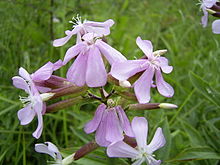- Common Soapwort
-
Common Soapwort 
Scientific classification Kingdom: Plantae (unranked): Angiosperms (unranked): Eudicots (unranked): Core eudicots Order: Caryophyllales Family: Caryophyllaceae Genus: Saponaria Species: S. officinalis Binomial name Saponaria officinalis
L.Common Soapwort (Saponaria officinalis) is a vespertine flower, and a common perennial plant from the carnation family (Caryophyllaceae). Other common names are Bouncing Bet and Sweet William; locally it is simply "the Soapwort" although there are about 20 species of soapworts altogether.
The scientific name Saponaria is derived from the Latin sapo (stem sapon-) meaning "soap," which, like its common name, refers to its utility in cleaning. From this same Latin word is derived the name of the toxic substance saponin, contained in the roots at levels up to 20 percent when the plant is flowering[1] (Indian soapnuts contain only 15 percent). It produces a lather when in contact with water. The epithet officinalis indicates its medicinal functions.
Soapwort's native range extends throughout Europe to western Siberia. It grows in cool places at low or moderate elevations under hedgerows and along the shoulders of roadways.
The plants possesses leafy, unbranched stems (often tinged with red). It grows in patches, attaining a height of 70 cm. The broad, lanceolate, sessile leaves are opposite and between 4 and 12 cm long. Its sweetly scented flowers are radially symmetrical and pink, or sometimes white. Each of the five flat petals have two small scales in the throat of the corolla. They are about 2.5 cm wide. They are arranged in dense, terminal clusters on the main stem and its branches. The long tubular calyx has five pointed red teeth.
In the northern hemisphere soapwort blooms from May to September, and in the southern hemisphere October to March.
External use
As the name implies, it can be used as a very gentle soap, usually in dilute solution. It has historically been used to clean delicate or unique textiles; it has been hypothesized that the plant was used to treat the Shroud of Turin.[2]
Internal use
Soapwort has various medicinal functions as an expectorant and laxative, but care should be taken when used as saponins may be toxic. An overdose can cause nausea, diarrhoea and vomiting.
Despite its toxic potential, soapwort finds culinary use as an emulsifier in the commercial preparation of tahini halva,[3] and in brewing to create beer with a good "head". In India, the rhizome is used as a galactagogue.[4]
References
- ^ Farmakognosia, by Raimo Hiltunen (in finnish)
- ^ Shroud of Turin
- ^ Seasoning Savvy: How to Cook With Herbs, Spices, and Other Flavorings By Alice Arndt, p.215
- ^ Purple Sage page on Soapwort
 Media related to Common Soapwort at Wikimedia CommonsCategories:
Media related to Common Soapwort at Wikimedia CommonsCategories:- Caryophyllaceae
- Medicinal plants
- Poisonous plants
Wikimedia Foundation. 2010.
